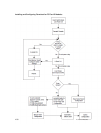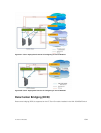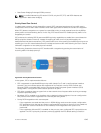Processing of Data Traffic
The Dell Networking OS determines the module type that is plugged into the slot. Based on the module
type, the software performs the appropriate tasks. The FC Flex IO module encapsulates and decapsulates
the FCoE frames. The module directly switches any non-FCoE or non-FIP traffic, and only FCoE frames
are processed and transmitted out of the Ethernet network.
When the external device sends FCoE data frames to the switch that contains the FC Flex IO module, the
destination MAC address represents one of the Ethernet MAC addresses assigned to FC ports. Based on
the destination address, the FCoE header is removed from the incoming packet and the FC frame is
transmitted out of the FC port. The flow control mechanism is performed using per-priority flow control
to ensure that frame loss does not occur owing to congestion of frames.
Operation of the FIP Application
The NPIV proxy gateway terminates the FIP sessions and responses to FIP messages. The FIP packets are
intercepted by the FC Flex IO module and sent to the Dell Networking OS for further analysis. The FIP
application responds to the FIP VLAN discovery request from the host based on the configured FCoE
VLANs. For every ENode and VN_Port that is logged in, the FIP application responds to keepalive
messages for the virtual channel. If the FC link becomes inactive or a logging off of the switch occurs, the
FIP engine sends clear virtual link (CVL) messages to the host. The FIP application also responds to
solicited advertisements from the end-device. In addition, the FIP application periodically sends
advertisement packets to the end-devices for each FCF that is part of the NPIV proxy gateway.
If FC Flex IO modules are installed, the I/O Aggregator does not perform FIP snooping because the FIP
frames are terminated on the switch for NPIV operations. However, on MXL Switches, you can configure
the switch to operate in FIP Snooping or NPIV mode.
If the MXL 10/40GbE Switch functions in the NPIV mode and you attempt to set the uplink port to be an
FCF or a bridge port, a warning message displays and the settings are not saved. On the Aggregator, if the
FC module is present, the uplink ports are not automatically set up as FCF or bridge ports. The FC Flex
module cannot function as both an NPIV proxy gateway and a FIP snooping bridge at the same time.
Operation of the NPIV Proxy Gateway
The NPIV application on the FC Flex IO module manages the FC functionalities configured in Dell
Networking OS. After the FC link comes up, the gateway sends the initial FLOGI request to the connected
switch using the switch and port WWN methods. After a successful login, the NPIV gateway sends a
notification to inform the CNA that the FCF available to log in. The source address of the FIP
advertisement and FIP discovery advertisement response contain the MAC address of the FC Flex IO
module port. Depending on the number of login sessions on a particular FCF, the NPIV gateway can
load-balance the login sessions from ENodes.
The NPIV application performs the FLOGI to FDISC conversion and sends the new FC frame on the
associated FC ports. After the external switch responds to the FLOGI request, the NPIV gateway
establishes the NPIV session and sends the frame to the FIP application. The FIP application establishes
virtual links to convert FCoE FLOGI accept messages into FIP FLOGI accept messages. The corresponding
ACL for the accept message is then applied. If a FIP timeout from ENode or VN_PORT occurs, the NPIV
application performs the FC fabric logout to the external FC switch. The NPIV application manages the
sessions between the FCoE and the FC domain.
1036
FC Flex IO Modules


















